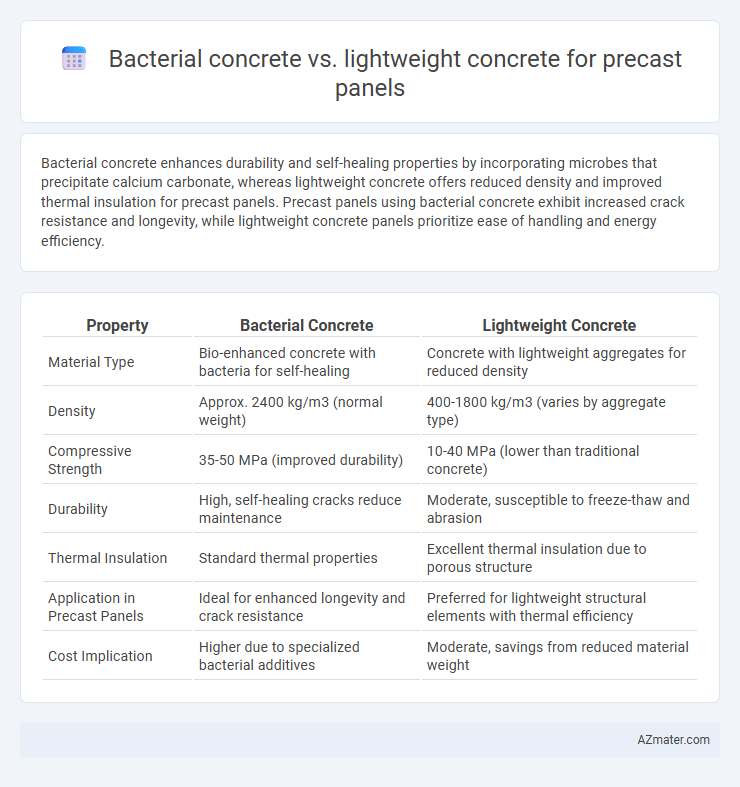Bacterial concrete enhances durability and self-healing properties by incorporating microbes that precipitate calcium carbonate, whereas lightweight concrete offers reduced density and improved thermal insulation for precast panels. Precast panels using bacterial concrete exhibit increased crack resistance and longevity, while lightweight concrete panels prioritize ease of handling and energy efficiency.
Table of Comparison
| Property | Bacterial Concrete | Lightweight Concrete |
|---|---|---|
| Material Type | Bio-enhanced concrete with bacteria for self-healing | Concrete with lightweight aggregates for reduced density |
| Density | Approx. 2400 kg/m3 (normal weight) | 400-1800 kg/m3 (varies by aggregate type) |
| Compressive Strength | 35-50 MPa (improved durability) | 10-40 MPa (lower than traditional concrete) |
| Durability | High, self-healing cracks reduce maintenance | Moderate, susceptible to freeze-thaw and abrasion |
| Thermal Insulation | Standard thermal properties | Excellent thermal insulation due to porous structure |
| Application in Precast Panels | Ideal for enhanced longevity and crack resistance | Preferred for lightweight structural elements with thermal efficiency |
| Cost Implication | Higher due to specialized bacterial additives | Moderate, savings from reduced material weight |
Introduction to Precast Panels
Precast panels are factory-manufactured concrete elements designed for quick installation and consistent quality in construction projects. Bacterial concrete enhances durability and self-healing properties through microbial-induced calcium carbonate precipitation, making it suitable for long-lasting precast panels. Lightweight concrete offers reduced density and improved thermal insulation, optimizing precast panel weight without compromising structural integrity.
Overview of Bacterial Concrete
Bacterial concrete incorporates specific microorganisms that induce bio-mineralization, promoting self-healing properties and enhancing durability by sealing micro-cracks autonomously. This innovative concrete type reduces maintenance costs and improves structural longevity, making it highly suitable for precast panels exposed to harsh environments. In comparison, lightweight concrete emphasizes reduced density and thermal insulation but lacks the self-repair capabilities intrinsic to bacterial concrete.
Overview of Lightweight Concrete
Lightweight concrete used in precast panels offers reduced density ranging from 1,200 to 1,800 kg/m3, improving structural efficiency and ease of handling compared to conventional concrete. It incorporates lightweight aggregates such as expanded clay, shale, or pumice, resulting in enhanced thermal insulation and fire resistance properties. The lower weight contributes to decreased foundation loads and transportation costs, making it ideal for high-rise buildings and modular construction systems.
Material Composition and Properties
Bacterial concrete incorporates specific bacteria and nutrients within traditional concrete mix to promote self-healing, enhancing durability and crack resistance through microbiological processes. Lightweight concrete uses aggregates such as expanded clay or pumice to reduce density, improving thermal insulation and reducing structural load but generally offering lower compressive strength compared to conventional mixes. In precast panels, bacterial concrete optimizes longevity and maintenance costs, while lightweight concrete emphasizes ease of handling and energy efficiency, making material composition critical in aligning with project performance requirements.
Strength and Durability Comparison
Bacterial concrete enhances strength and durability in precast panels by improving self-healing properties through microbial-induced calcite precipitation, effectively sealing microcracks and reducing porosity. Lightweight concrete offers reduced density and improved thermal insulation but generally exhibits lower compressive strength and higher permeability compared to bacterial concrete, impacting long-term durability. For precast panels requiring superior mechanical performance and extended lifespan, bacterial concrete provides a significant advantage over lightweight concrete in maintaining structural integrity under aggressive environmental conditions.
Weight and Handling Efficiency
Bacterial concrete offers enhanced self-healing properties and slightly increased density compared to traditional mixes, resulting in heavier precast panels that may require more effort during handling. Lightweight concrete, with its reduced density typically ranging from 1440 to 1840 kg/m3, significantly lowers the weight of precast panels, improving handling efficiency and reducing transportation costs. The choice between bacterial and lightweight concrete depends on balancing the benefits of durability and weight reduction to optimize overall project performance.
Environmental Impact and Sustainability
Bacterial concrete demonstrates enhanced environmental sustainability by utilizing bio-mineralization processes to self-heal cracks, reducing the need for frequent repairs and extending the lifespan of precast panels, which lowers overall resource consumption and carbon emissions. Lightweight concrete, while offering advantages in reducing structural load and transportation energy due to its lower density, often involves energy-intensive manufacturing and may rely on non-renewable raw materials, impacting its sustainability profile. The integration of bacterial technology in concrete precast panels presents a promising innovation that significantly improves environmental impact by mitigating maintenance demands and enhancing durability compared to conventional lightweight concrete solutions.
Cost Analysis and Economic Considerations
Bacterial concrete incorporates microbial-induced calcite precipitation for self-healing, resulting in reduced maintenance costs despite a higher initial investment compared to lightweight concrete, which offers lower density and reduced transportation expenses. Lightweight concrete's cost-effectiveness stems from cheaper raw materials and faster curing times, making it suitable for large-scale precast panel production with budget constraints. Economic considerations favor bacterial concrete for long-term savings through durability and longevity, while lightweight concrete remains advantageous for projects prioritizing upfront cost efficiency and ease of handling.
Suitability for Precast Panel Applications
Bacterial concrete enhances durability and self-healing properties, making it highly suitable for precast panels exposed to aggressive environments or requiring extended service life. Lightweight concrete offers reduced weight and improved thermal insulation, beneficial for large precast panels where transport and handling efficiency are critical. Selection depends on specific project priorities: prioritize bacterial concrete for longevity and sustainability, while lightweight concrete is preferred for structural efficiency and ease of installation.
Conclusion: Choosing the Optimal Concrete Type
Bacterial concrete enhances durability and self-healing capabilities, making it ideal for precast panels exposed to harsh environmental conditions and requiring long-term maintenance reduction. Lightweight concrete offers superior thermal insulation and reduced structural load, optimizing energy efficiency and simplifying transportation and handling in precast panel production. Selecting the optimal concrete type depends on project priorities such as durability, sustainability, load requirements, and environmental exposure.

Infographic: Bacterial concrete vs Lightweight concrete for Precast panel
 azmater.com
azmater.com